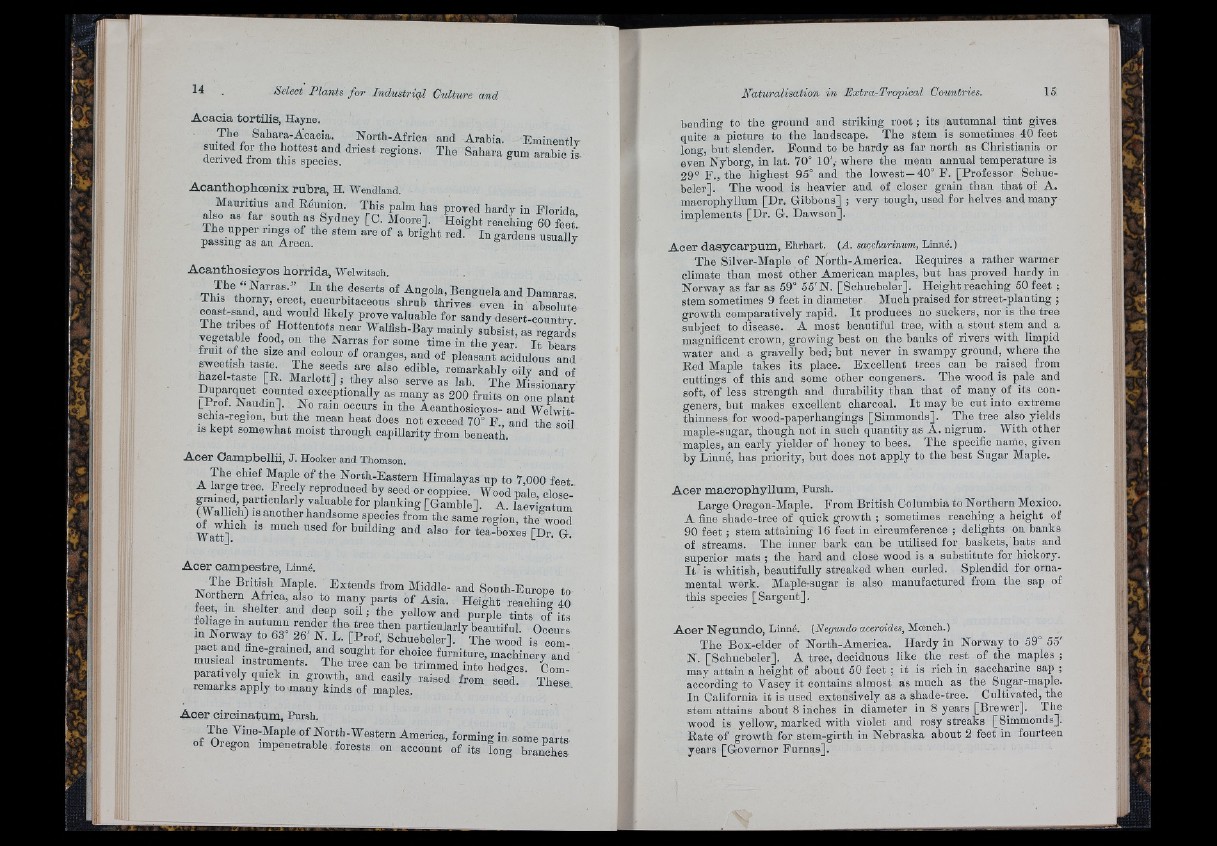
A c a c ia to r tilis , Hayue.
The Sahara-Àcacia. North-Africa and Arabia. Eminently
suited for the hottest and driest regions. The Sahara gum arabic is
derived from this species.
A c a n th o p hoe n ix ru b r a , H. Wendland.
Mauritius and Reunion. This palm has proved hardy in Florida
also as far south as Sydney [C. Moore]. Height reaching 60 feet’
p a tn T a T a T iil" ^ ^ ^ - - U y
A c a n th o s ic y o s h ó rr id a , Welwitsch.
Angola, Rengúela and Damaras
This thorny, erect, cucurbitaceous shrub thrives even in absolute
coast-sand, and would likely prove valuable for sandy desert-country
Teïet n®% ^alfisîi-Bay mainly subsist, as regards'
vegetable food, on the Narras for some time in the year. I t bears
fruit of the size and colour of oranges, and of pleasant acidulous and
sweetish ta s fe The seeds are also edible, remarkably oily and of
hazel-taste [R. Marlott] ; they also serve as lab. The Missionary
[Rrot. Naudin]. No ram occurs in the Acanthosicyos- and Welwit-
schia-region, but the mean heat does not exceed 70° F., and the soil
is kept somewhat moist through capillarity from beneath.
A c e r Oampbellii, J. Hooker and Thomson.
The chief Maple of the North-Eastern Himalayas up to 7,000 feet
A large tree. Freely reproduced by seed or coppice. Wood pale close
grained, particularly valuable for planking [Gamble]. A. laevigatnm
(Walhch) IS another handsome species from the same region, the wood
W a tt] “ "«h used for building and also for te a -to x ’es [dI g .
A c e r c am p e s tre , Linné.
AtJ Í® Middle- and South-Europe to
feet, in^ shelter, and deep soil ; the yellow and purple tints of its
folmge in autumn render the tree then particularly beautiful Occurs
in Norway to 63[ 26' N. L. [Prof. Schnebeler]. The wood is com!
pact and fine-grained, and sought for choice furniture, machinery and
musical instruments. The tree can be trimmed into’liedges
paratively quick in growth, and easily raised from s e e l These
remarks apply to many kinds of maples.
A c e r c ir c in a tum , Pursh.
The Vine-Maple of North-Western America, forming in some parts
of Oregon impenetrable forests on account of its long branches
bending to the ground and striking ro o t; its autumnal tint gives
quite a picture to the landscape. The stem is sometimes 40 feet
long, but slender. Found to be hardy as far north as Christiania or
even Nyborg, in lat. 70° 10',- where the mean annual temperature is
29° F., the highest 95° and the lowest—40° F. [Professor Schue-
beler]. The wood is heavier and of closer grain than th a t of A.
macrophyllum [Dr. Gibbons] ; very tough, used for helves and many
implements [Dr. G. Dawson].
A c e r d a s y c a rp um , Ehrhart. (A. saccharinwm, Linné.)
The Silver-Maple of North-America. Requires a rather warmer
climate than most other American maples, but has proved hardy in
Norway as far as 59° 65' N. [Schnebeler]. Height reaching 50 feet ;
stem sometimes 9 feet in diameter Much praised for street-planting ;
growth comparatively rapid. I t produces no suckers, nor is the tree
subject to disease. A most beautiful tree, with a stout stem and ^ a
mao-niflceiit crown, growing best on the banks of rivers with limpid
water and a gravelly bed; but never in swampy ground, where the
Red Maple takes its place. Excellent trees can be raised from
cuttings of this and some other congeners. The wood is pale and
soft, of less strength and durability than th a t of many of its congeners,
but makes excellent charcoal. I t may he cut into extreme
thinness for wood-paperhangings [Simmonds]. The tree also yields
maple-sugar, though not in such quantity as A. nigrum. With other
maples, an early yielder of honey to bees. The specific name, given
by Linné, has priority, but does not apply to the best Sugar Maple.
A c e r m a c ro p h y llum , Pursh.
Large Oregon-Maple. From British Columbia to N orthern Mexico.
A fine shade-tree of quick growth ; sometimes reaching a height of
90 f e e t; stem attaining 16 feet in circumference ; delights on banks
of streams. The inner bark can be utilised for baskets, hats and
superior mats ; the hard and close wood is a substitute for hickory.
I t is whitish, heautifully streaked when curled. Splendid for ornamental
work. Maple-sugar is also manufactured from the sap of
this species [Sargent].
A c e r N e g u n d o , Linné. (Negundo aceroides, Mcenoh.)
The Box-elder of North-America. Hardy in Norway to 59° 55'
N. [Schnebeler]. A tree, deciduous like the rest of the maples ;
may attain a height of about 50 feet ; it is rich in saccharine sap ;
according to Vasey it contains almost as much as the Sugar-maple.
In California it is used extensively as a shade-tree. Cultivated, the
stem attains about 8 inches in diameter in 8 years [Brewer]. The
wood is yellow, marked with violet and rosy streaks [Simmonds].
Rate of growth for stem-girth in Nebraska about 2 feet in fourteen
years [Governor Furnas].